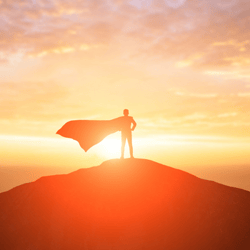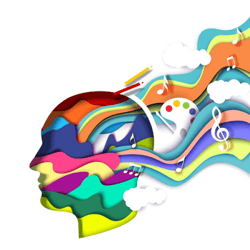
What is an archetype? On first hearing the term, you might think it means something like “stereotype.” But archetypes are far richer and more interesting than that, and provide one of the foundational aspects of Jungian depth psychology. One of the earliest beginnings of the idea may be Plato’s writings in the fourth century B.C.E.. Although he did not use the actual term archetype (in Greek, “arche” original, and “typos” form), he did use the term eidos, translated as either Form or Idea. But it was not until the Swiss psychologist, and the founder of analytical psychology, C. G. Jung took up archetypes in works such as The Archetypes and the Collective Unconscious in the first half of the 20th century that it came into prominence in theoretical and psychological discourse.
As Keiron Le Grice, Pacifica’s Co-Chair of the Jungian and Archetypal Studies specialization of the Depth Psychology program, describes Jung’s view of archetypes, “[They] are the universal principles, patterns, and powers that move us all and shape our lives from the collective unconscious—the containing psychological matrix underlying consciousness. They are the governing principles in the background of experience that together comprise a kind of thematic framework within which our lives unfold. The archetypes manifest within and through our thoughts and feelings, drives and desires, and through circumstances and events in the world. They are not causes in the usual sense, but they are enacted by and revealed through causal chains of events.”
Jung focused primarily on a few foundational archetypes, including the shadow, anima, animus, and the Self. Taking myths and symbols as expressions of the psyche, and therefore reflective of the psyche, Jung identified a number of other archetypes, which Le Grice describes as “the hero, the mother, the child, the trickster, the archetype of the spirit (of which the wise old man is one form), rebirth, and Dionysus.” These have trickled down in popular perception into categories such as the sage, the innocent, the explorer, the rebel, the hero, the trickster, the lover, the caregiver, etc.
Archetypal Astrology
 While Jung discussed many more than twelve archetypes and said there is “an archetype for every typical situation,” popular commentary often simplifies this down to “the twelve Jungian archetypes,” which are often paired and compared with the European Zodiac. Jung himself said, “The starry vault of heaven is in truth the open book of cosmic projection, in which are reflected the mythologems, i.e., the archetypes.” It is no surprise then, that archetypal astrology is a burgeoning field of psychological inquiry. Safron Rossi, Ph.D., a core faculty member of Pacifica’s Jungian and Archetypal Studies M.A./Ph.D. program, says that archetypal astrology “emphasizes certain threads. Archetypal astrology is anchored in C.G. Jung’s psychology and his notion of the archetypes. So one of the primary ideas is that our birth chart, the planets, signs and their configurations, symbolize the archetypal patterns of the psyche. In other words, archetypes are living forces within us and astrology maps out those forces symbolically.”
While Jung discussed many more than twelve archetypes and said there is “an archetype for every typical situation,” popular commentary often simplifies this down to “the twelve Jungian archetypes,” which are often paired and compared with the European Zodiac. Jung himself said, “The starry vault of heaven is in truth the open book of cosmic projection, in which are reflected the mythologems, i.e., the archetypes.” It is no surprise then, that archetypal astrology is a burgeoning field of psychological inquiry. Safron Rossi, Ph.D., a core faculty member of Pacifica’s Jungian and Archetypal Studies M.A./Ph.D. program, says that archetypal astrology “emphasizes certain threads. Archetypal astrology is anchored in C.G. Jung’s psychology and his notion of the archetypes. So one of the primary ideas is that our birth chart, the planets, signs and their configurations, symbolize the archetypal patterns of the psyche. In other words, archetypes are living forces within us and astrology maps out those forces symbolically.”
So let’s explore some of the archetypes and how they might translate into mythological and even cinematic characters that we recognize as universal types.
The Hero
 Perhaps the most well-known of the archetypes, thanks to Joseph Campbell’s The Hero’s Journey, is that of the hero. Campbell described the hero’s journey as “the courage to seek the depths; the image of creative rebirth; the eternal cycle of change within us; the uncanny discovery that the seeker is the mystery which the seeker seeks to know.” Or as Jung put it in Archetypes and the Collective Unconscious, “The hero’s main feat is to overcome the monster of darkness: it is the long-hoped-for and expected triumph of consciousness over the unconscious.” A classic example of the hero is King Arthur or Odysseus. But in more modern terms, consider Katniss Everdeen from The Hunger Games, or even Harry Potter. All face struggle and epic obstacles to redeem their world, and in psychological terms, as Keiron Le Grice, Ph.D., phrases it, “partake in, and give symbolic expression to, the process of individuation.”
Perhaps the most well-known of the archetypes, thanks to Joseph Campbell’s The Hero’s Journey, is that of the hero. Campbell described the hero’s journey as “the courage to seek the depths; the image of creative rebirth; the eternal cycle of change within us; the uncanny discovery that the seeker is the mystery which the seeker seeks to know.” Or as Jung put it in Archetypes and the Collective Unconscious, “The hero’s main feat is to overcome the monster of darkness: it is the long-hoped-for and expected triumph of consciousness over the unconscious.” A classic example of the hero is King Arthur or Odysseus. But in more modern terms, consider Katniss Everdeen from The Hunger Games, or even Harry Potter. All face struggle and epic obstacles to redeem their world, and in psychological terms, as Keiron Le Grice, Ph.D., phrases it, “partake in, and give symbolic expression to, the process of individuation.”
The Shadow
 The shadow does not need to be a human. It might well be a monster or a feared animal appearing in a dream or vision, a demon or anything that represents a threat to the known, ordered world. As Erich Neumann, a student of Jung and the author of Depth Psychology and a New Ethic, wrote, “All those qualities, capacities and tendencies which do not harmonize with the collective values…now come together to form the shadow, that dark region of the personality which is unknown and unrecognized by the ego. The endless series of shadow and doppelgänger figures in mythology, fairy tales and literature ranges from Cain and Edom, by way of Judas and Hagen, to Stevenson’s Mr. Hyde in the ugliest man of Nietzsche; again and again such figures have appeared and made their bow before human consciousness.” Or consider Gollum, from Lord of the Rings. Riddled with violent impulses, desire, and obsession, Gollum contains many characteristics condemned by society, thereby causing shame and self-loathing.
The shadow does not need to be a human. It might well be a monster or a feared animal appearing in a dream or vision, a demon or anything that represents a threat to the known, ordered world. As Erich Neumann, a student of Jung and the author of Depth Psychology and a New Ethic, wrote, “All those qualities, capacities and tendencies which do not harmonize with the collective values…now come together to form the shadow, that dark region of the personality which is unknown and unrecognized by the ego. The endless series of shadow and doppelgänger figures in mythology, fairy tales and literature ranges from Cain and Edom, by way of Judas and Hagen, to Stevenson’s Mr. Hyde in the ugliest man of Nietzsche; again and again such figures have appeared and made their bow before human consciousness.” Or consider Gollum, from Lord of the Rings. Riddled with violent impulses, desire, and obsession, Gollum contains many characteristics condemned by society, thereby causing shame and self-loathing.
The Artist or Creator
 You can find the study of archetypes and their influence on depth psychology in all of Pacifica’s programs. But one of the programs I find most unique is the M.A. Depth Psychology and Creativity with Emphasis in the Arts and Humanities, chaired by Mary A. Wood, Ph.D. As Mary says, “There’s been a tremendous swell of interest in the concept of archetypes in recent years. I make it clear in The Archetypal Artist: Reimagining Creativity and the Call to Create that one cannot ‘be’ an archetype. We can, however, be influenced, driven, or claimed by archetypal patterns and energies. A sensitive eye attuned to archetypes will see these forces at work in every arena of human life, from family dynamics to politics. Through the crafting of objects and experiences, artists can bring these forces into focus for the benefit of all. Archetypes per se are inherently formless but they show up in archetypal images.” So perhaps when we point to a character in film or literature and say they are an archetype, it would be more accurate to say they are representative of patterns that are archetypal.
You can find the study of archetypes and their influence on depth psychology in all of Pacifica’s programs. But one of the programs I find most unique is the M.A. Depth Psychology and Creativity with Emphasis in the Arts and Humanities, chaired by Mary A. Wood, Ph.D. As Mary says, “There’s been a tremendous swell of interest in the concept of archetypes in recent years. I make it clear in The Archetypal Artist: Reimagining Creativity and the Call to Create that one cannot ‘be’ an archetype. We can, however, be influenced, driven, or claimed by archetypal patterns and energies. A sensitive eye attuned to archetypes will see these forces at work in every arena of human life, from family dynamics to politics. Through the crafting of objects and experiences, artists can bring these forces into focus for the benefit of all. Archetypes per se are inherently formless but they show up in archetypal images.” So perhaps when we point to a character in film or literature and say they are an archetype, it would be more accurate to say they are representative of patterns that are archetypal.
Looking for examples in film, we see creators as visionaries, who are driven to produce new ideas and inventions that are of benefit to the world. Some are so driven that they may not fit within mainstream society. Examples in literature and film might be Willy Wonka, reclusive inventor and chocolate genius, or Tony Stark, inventor of the Iron Man suit, who also veers into the archetype of the hero.
The Mentor or Sage
 For every hero trying to find his way through a tale, there is often the older, wiser character who advises, educates, and encourages. Also known as the Sage, one who seeks knowledge of the inner of the self. As Jung put it, “One does not become enlightened by imagining figures of light, but by making the darkness conscious.” Without the mentor, the hero would never find the strength or wisdom to overcome all of those hurdles that stand before them. Yoda from Star Wars, Gandalf from Lord of the Rings, Dumbledore from Harry Potter, or Merlin from the Arthurian legend are all examples. And although Jung preferred the gendered term “senex” (wise old man as a form of the archetype of the spirit), and Hollywood often follows suit, think of Princess Leia mentoring Rei in Star Wars, Minerva McGonagall in Harry Potter, or Cinderella’s fairy godmother.
For every hero trying to find his way through a tale, there is often the older, wiser character who advises, educates, and encourages. Also known as the Sage, one who seeks knowledge of the inner of the self. As Jung put it, “One does not become enlightened by imagining figures of light, but by making the darkness conscious.” Without the mentor, the hero would never find the strength or wisdom to overcome all of those hurdles that stand before them. Yoda from Star Wars, Gandalf from Lord of the Rings, Dumbledore from Harry Potter, or Merlin from the Arthurian legend are all examples. And although Jung preferred the gendered term “senex” (wise old man as a form of the archetype of the spirit), and Hollywood often follows suit, think of Princess Leia mentoring Rei in Star Wars, Minerva McGonagall in Harry Potter, or Cinderella’s fairy godmother.
So what is the importance of archetypes in depth psychology? Dylan Hoffman, Ph.D., Core Faculty at Pacifica, writes that “Archetypes are not just the forces behind fantasy, art, myth, and culture, they are the spirits, the energies, made material in our bodies, in ecology, and in the cosmos.” And as such, he posits, “For most of human history, neglect of these archetypal powers, or their violation—whether done intentionally or out of ignorance—has been understood as the cause of illnesses of both body and soul, as the source of communal breakdown, and as the derivation of ecological decline. In contrast, their remembrance and care have been considered the means of regaining rapport with all that is, since archetypes are the ground principles of existence. Depth psychology takes this history to heart, finding in it the context and meaning of modern psychological experiences of passion, pathology, and possession—of what make us human and inhumane, gives us our propensities for madness and the monstrous, and the capacities to create beauty, experience the numinous, and realize what it means to be whole.”
Intrigued to know more? Pacifica’s Depth Psychology with Specialization in Jungian Psychology and Archetypal Studies Program or the M.A. Depth Psychology and Creativity with Emphasis in the Arts and Humanities are good places to start!
 Angela Borda is a writer for Pacifica Graduate Institute, as well as the editor of the Santa Barbara Literary Journal. Her work has been published in Food & Home, Peregrine, Hurricanes & Swan Songs, Delirium Corridor, Still Arts Quarterly, Danse Macabre, and is forthcoming in The Tertiary Lodger and Running Wild Anthology of Stories, Vol. 5.
Angela Borda is a writer for Pacifica Graduate Institute, as well as the editor of the Santa Barbara Literary Journal. Her work has been published in Food & Home, Peregrine, Hurricanes & Swan Songs, Delirium Corridor, Still Arts Quarterly, Danse Macabre, and is forthcoming in The Tertiary Lodger and Running Wild Anthology of Stories, Vol. 5.



